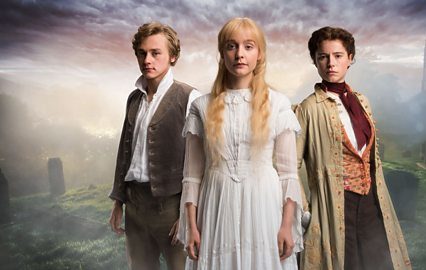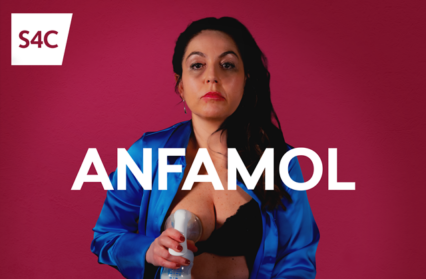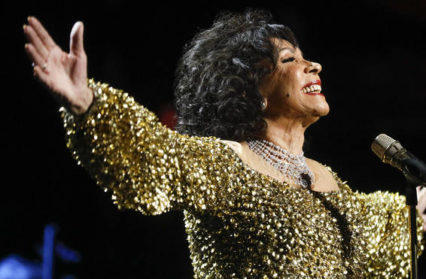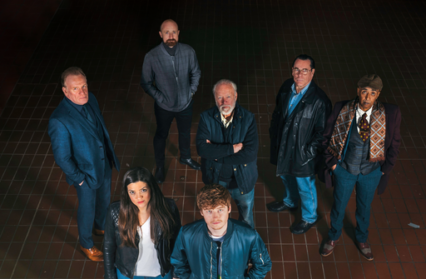What happened to Marian’s moustache? Angela Graham considers the implications of modern adaptations of classic novels; looking at the recent BBC version of Wilkie Collins’ The Woman in White, she asks if the profound and unusual themes of Victorian texts are watered down for the 21st Century sensibility.
Making points about the script of a television drama series that is done, dusted and broadcast is justifiable in relation to productions to come and I’m interested in an evergreen issue –how much period reality can the contemporary viewer bear?
The BBC is rightly famous for its adaptations of works of English literature and returns to the same favourites periodically on a menu that contains plenty of good things still to be tackled. This latest version of The Woman In White on BBC 1 in the Sunday evening slot (itself by now a classic for the classics) has just finished. To what degree ought literature from the past be moulded to present tastes and mores when it is adapted for the broad viewership of mainstream tv channels?
A classic of literature endures because it has captured elements profound enough to be relevant across time. When it is adapted into a fresh medium in another age the danger is that poor decisions are made in removing elements judged to be straining the audience’s credulity. When this happens the work’s impact is taken down a notch or two. It becomes more like others of its genre from its own time and ours and less like itself. From standing head and shoulders above the crowd, it is lost in it. The art must lie both in judging what the obstacles to today’s viewers actually are and in a standpoint on the value, or otherwise, of positioning the viewer within a worldview different in certain respects to today’s.
On the latter point, in my view it’s nothing but a broadening and an enhancement to encounter that different perspective from another age; the adapter is not obliged to avoid all critique of it but this needs to be done subtly, while preserving the integrity of the original vision to a large degree.
When one reads a Victorian book one is doing this oneself, absorbing the original through the mesh of one’s twenty-first century sensibilities. In a tv adaptation the adapter performs, necessarily, a large part of this role and that’s why the adapter’s work is so crucial because it stands between the work and its ‘reader’ in this new medium.
Wilkie Collins’s 1860 novel The Woman In White makes lavish use of contrasts between outward appearance and inner reality and between conflicting aspects of the same person. Although this season’s adaptation retains the key plot device of two young women who closely resemble each other and the dastardly use made of this by the villains, it dispenses with one of the most memorable of the novel’s dualities: the unconventionality of the personal appearance of both Marian Halcombe and Count Fosco, and the complex relationship between these two characters.
In the current series we are given a watered-down, generic dynamic that delivers a meh version – so they fancy each other and there’s a bit of repression going on, or is it self-control? So what? There’s not that much at stake. Count Fosco is allowed to mutter something about risking divorce for Marian’s sake but it’s something and nothing as we never feel what that might cost. Was it feared that the modern viewer will baulk at sexual attraction occurring between people who are not conventionally attractive? If so, this seems at odds with contemporary efforts to admit a wide range of erotic possibilities. Or was it thought that today’s audience will not believe in characters who do not indulge their passions? If so, this obliges the adapter to wrench the world of the novel into contortions it was never designed to perform and it deprives the audience of an opportunity to view the world through the lens of a time not their own.
An audience needs to be served, not ignored, and Wilkie Collins kept a pragmatic eye on his readers every bit as much as today’s TV writer needs to keep his or hers in mind. Adaptation necessarily involves some re-focusing in order to clarify anything that time has blurred, anything that would impede the story. In this 2018 adaptation of The Woman In White, some of the changes made have been too costly in terms of depth and subtlety. This is most obvious in the conception of Marian Halcombe and Count Fosco.
The novel offers a relationship between these two characters which is complex and counter-intuitive and therefore more enjoyable to engage with. The low setting of the bar shows up early in the tv adaptation when Walter Hartright first catches sight of Marian Halcombe. Her shin is visible as she fiddles with her boot. And she’s not embarrassed to find he has been watching. That is the limit of her unconventionality, apart from wearing a divided skirt and no corsets.
Contrast this with the novel:
I looked from the table to the window farthest from me, and saw a lady standing at it, with her back turned towards me. The instant my eyes rested on her, I was struck by the rare beauty of her form, and by the unaffected grace of her attitude… I allowed myself the luxury of admiring her for a few moments… She turned towards me immediately. The easy elegance of every movement of her limbs and body, as soon as she began to advance from the far end of the room, set me in a flutter of expectation to see her face clearly. She left the window and I said to myself, The lady is dark. She moved forwards a few steps; and I said to myself, The lady is young. She approached nearer; and I said to myself (with a sense of surprise which words fail me to express), The lady is ugly!…
The slow reveal (a highly visual rendering) is a bit hammy but it works.
… never was the fair promise of a lovely figure more strangely and startlingly belied by the face and head that crowned it. The lady’s complexion was almost swarthy, and the dark down on her upper lip was almost a moustache. She had a large masculine mouth and jaw; prominent, piercing, resolute brown eyes; and thick, coal-black hair, growing unusually low down on her forehead…
And then we are given
To be almost repelled by the masculine look of the features in which the perfectly shaped figure ended – was to feel a sensation oddly akin to the helpless discomfort familiar to us all in sleep, when we recognize yet cannot reconcile the anomalies and contradictions of a dream.
Anomalies and contradictions abound in the book. Marian does not conform to the male expectation. She frustrates and perplexes the male gaze which is forced to reassess her womanliness and her capacities. Much is made of her ‘masculine’ qualities, by herself and others. She is daring, logical, buoyant, strategic in contrast to Laura Fairlie, the angelic love-interest of the rather staid hero, Walter (and he is repeatedly up-staged by the anti-hero, Fosco).
Marian’s emotional reaction to the obese but compelling Count Fosco is intriguing because she is aware of her dislike of his appearance and of aspects of his character, which seems to combine force and sweetness; the gentle and the ruthless. Fosco is handsome in a monumental way but, as Marian acknowledges, his power is in his eyes:
They are the most unfathomable grey eyes I ever saw, and they have at times a cold, clear, beautiful, irresistible glitter in them which forces me to look at him, and yet causes me sensations, when I do look, which I would rather not feel.
It’s clear what’s going on here: the force of something beyond the rational is exerted. Wilkie Collins is not going to spoil the effect by being too specific. He understands the power of what is not explicit. The television adaptation lacks this degree of confidence.
Collins also undercuts the danger of over-egging the villainous pudding by making Fosco playful as well as deadly. He takes himself immensely seriously and can yet stand aside and admire his own performances. No wonder Marian is dazzled:
I am almost afraid to confess it to these secret pages. The man has interested me, has attracted me, has forced me to like him…. All the smallest characteristics of this strange man have something strikingly original and perplexingly contradictory in them…
He flatters my vanity by talking to me as seriously and as sensibly as if I was a man…
I certainly never saw a man, in all my experience, whom I should be so sorry to have for an enemy. Is this because I like him, or because I am afraid of him? Chi sa?… Who knows?
The enemy/friend potential is marked at several points, and the prominence of the ego, as when Fosco exclaims:
I lament the cruel necessity which sets our interests at variance, and opposes us to each other. Under happier circumstances how worthy I should have been of Miss Halcombe; how worthy Miss Halcombe would been of ME!
One of the pleasures of the book is the reader’s awareness of how this villain and this heroine have something profoundly in common with each other and what combustion could have resulted from their pairing, as Fosco expresses it:
Just Heaven! With what inconceivable rapidity I learnt to adore that woman. At sixty, I worshipped her with the volcanic ardour of eighteen. All the gold of my nature was poured hopelessly at her feet. My wife… who adores me, got nothing but the shillings and the pennies.
Beyond appearance, other forces of attraction are at work. The conventionally virtuous and handsome (the Walters, the Lauras) pair up in conventional and virtuous ways but the Marians and the Foscos are operating at a level altogether earthier and, at the same time, giving the attractions of the intellectual room to play.
Other aspects of this adaptation work well even though Laura is a much more forward young woman than the novel’s version. Again, this seems to be at attempt to make the presentation more ‘accessible’ to today’s viewers. To this end, complexity is sacrificed once more in the character of Walter’s friend, Pesca. In the novel he is described thus:
Without being actually a dwarf – for he was perfectly well proportioned from head to foot − Pesca was, I think, the smallest human being I ever saw out of a showroom. Remarkable anywhere by his personal appearance, he as still further distinguished among the rank and file of mankind by the harmless eccentricity of his character.
In the series he is shorn of the memorable idiosyncrasies of speech and person which the novel gives him and becomes a generic, slightly florid Italian.
Wilkie Collins himself was an eye-catching person. He had a large head on a small body, was affected by tics, dressed flamboyantly and cultivated a raffish, bohemian persona. He had a colourful personal life. He lived with Caroline Graves, mother to an illegitimate son by another man, a fact his friend, Charles Dickens took care to conceal from his own children.
Collins was well-acquainted with the inequities in the relations between men and women. The villains in his story frequently marvel at the capacity of a woman such as Marian to play them at their own game. The ‘masculine’ qualities are undoubtedly given high value. What we remember is Marian’s ability to combine both male and female characteristics and Collins finds a way (admittedly somewhat slick) to give Marian the last word, via the pen of Walter Hartright:
Marian was the good angel of our lives; let Marian end our story.
The series gives Marian the last image, dressed in local style, in a dusty Middle Eastern location (interestingly, we are expected to decode that correctly as ‘redoutable venturer’). Her last action, direct to camera, is – to veil her face! We are never going to see that moustache.
You might also like…
Sophie Baggott reviews Matthew Francis’ seventh poetry collection, Wing, an introspective ‘labour of love’ about interactions with nature.
Angela Graham is a contributor to Wales Arts Review.












